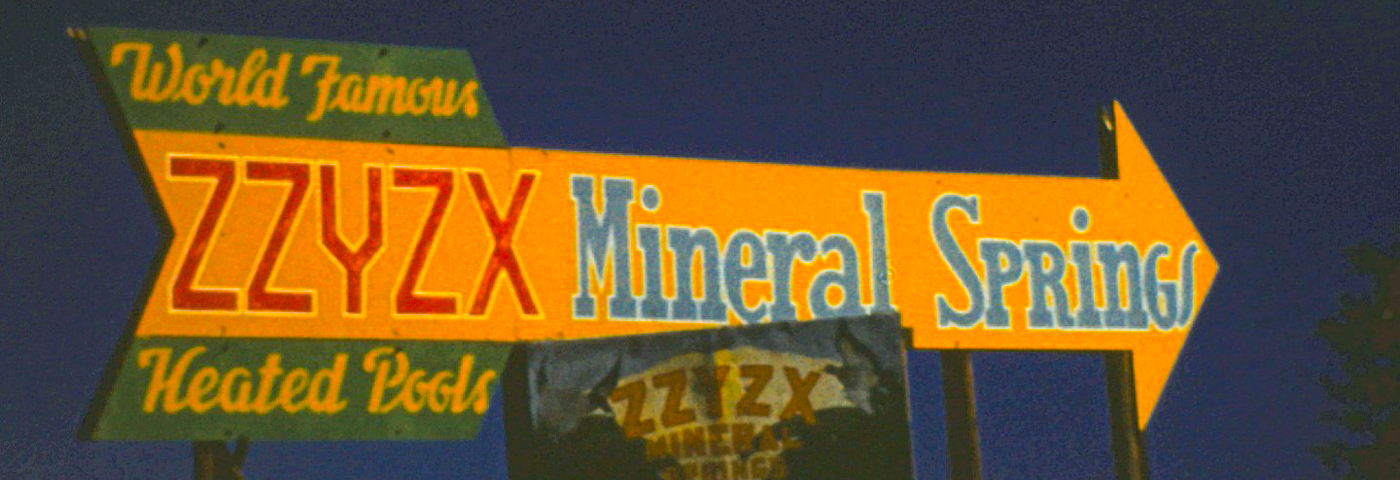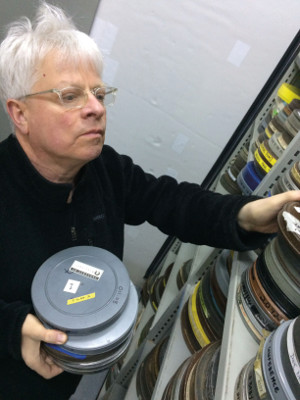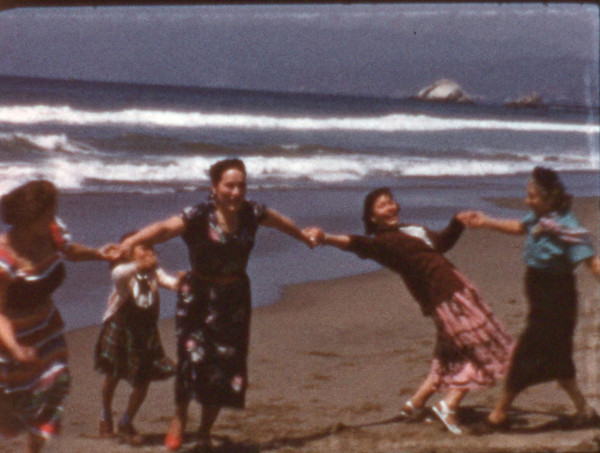
Viewing lost landscapes
Home movies capture history through a personal lens
During the late 1930s, Ivan Besse, a theater manager in Britton, South Dakota, filmed home movies of his town and its inhabitants and showed them as shorts before the features he screened at the local Strand Theater. In these films, men husk corn, snowstorms blow in, kids pour out of the schoolhouse at the end of the day—each scene recording a moment of daily life during the waning years of the Great Depression.

When UC Santa Cruz professor of film and digital media Rick Prelinger found these films 50 years later, he was enchanted, and brought them back to Britton to show them again on the Strand’s movie screen. During most films, the audience sits silently while the movie plays. But this time, when Prelinger turned on the projector, people started talking. They pointed at the screen, calling out the names of people, of places, of relatives and friends—some long gone, others, like Besse, sitting in the theater with them. “I’d never seen people talk back to the screen like that,” said Prelinger.
Prelinger, a film archivist, had been amassing a collection of “forgotten” 20th-century films, from advertising to educational and industrial films, to government-sponsored shorts. Home movies like the ones he showed in South Dakota turned him into a filmmaker. In the Lost Landscapes series, his compiled and edited films provide portraits of a city and its people through this most personal of lenses. So far, he’s presented films about San Francisco, Detroit, Oakland, Los Angeles, and, in 2017, New York City. He has also created several thematic films, including No More Road Trips?, an automobile-based adventure across the country, told through home movies. For researchers, home movies can broaden their understanding of issues such as gender dynamics and reveal history not caught on mainstream film. The films also offer a path to the future, Prelinger said, one in which people can collectively experience these images of the past and use them to help shape what they want their communities to become.
Personal to public
Home movies are typically considered second-class citizens of the film world. “Home movies have been treated by professionals and cinema experts—scholars, critics, and serious filmmakers—as something that hobbyists and amateurs did that was of, at best, documentary value,” said Prelinger’s UCSC colleague Jonathan Kahana, professor of film and digital media. People began using handheld movie cameras in the 1920s, and their use expanded in the following decades. These cameras allowed people to record their personal lives—from family birthdays to summer vacations—and to preserve and share these memories on a small scale. Capturing time, places, and people through a small lens, the resulting movies were “treated as unskilled, unpolished, unreliable, and, to anyone but their subjects, nearly unwatchable,” Kahana said.

But as Prelinger observed in the South Dakota theater, these movies are transformed when they emerge from the family room, and so are the people watching them. “Something very interesting happens when movies made for showing on a small scale get blown up to the size of a theater screen. Details jump out. Audiences become much more contemplative,” he said. Viewers pick out buildings lost to modernization, recognize changing styles in clothing and social interactions, and become cultural ethnographers and geographers in their own right. “Home movies,” said Prelinger, “turn ordinary viewers into sophisticated visual analysts.”
While usually intended to document personal moments, home movies also preserve the landscape that surrounds them. Scenes of children riding bicycles down the street can include backdrops of buildings now lost to new developments; footage of rural areas may document the arrival of telephone lines, roads, tracts of homes in place of fields. In Prelinger’s films of San Francisco, footage from a glider club in the 1920s reveals a Sunset District covered with dunes, not houses. “These films create a visual history of the 20th century, captured by people who didn’t have public agendas, who weren’t working to an official brief,” said Heather Norris Nicholson, visiting researcher at the University of Huddersfield, United Kingdom.
Hidden history
Home movies, and the films that Prelinger has made from them, reveal lost cultural as well as physical landscapes. Once 8 mm cameras and film were introduced in 1933, home movies became more affordable and accessible to a wider segment of America, enabling families of color and those in working-class and rural communities to start shooting their own films.
In editing footage for his San Francisco films—he has been showing a new one each year since 2006 to sold-out crowds—Prelinger uncovered movies from a 1950s Latino family that showed them celebrating birthdays, confirmations, and family holidays. “The family is so charismatic. Their body language is a joy to observe,” he said. Their home movies counter the notion that working-class San Francisco at the time was all white and Catholic; other segments show street scenes with diverse pedestrians, the homeless population in the 1950s before the South of Market area was developed, African Americans in the crowd at the 1956 Republican Party Convention. “There’s a sense of justice in filling gaps in the record,” said Prelinger, who joined the UC Santa Cruz faculty in 2013.
This information can help shift preconceived perceptions about the past. Nicholson, coauthor of the forthcoming book British Women Amateur Filmmakers: National Memories and Global Identities, said one of the things she loves about amateur film is its ability to “open up alternative ways of seeing place and people and experiences of the past.” While most people think of the 1950s as a single decade where everyone had the same traditional experience, these small, filmed moments show the heterogeneity of the past. For example, films made by the head teacher of a northern English nursery school during this period document many men dropping off and picking up their children. This could counter the notion that men were not as involved with child care during that time. But it could also reflect male unemployment in the area, or parents needing to balance shiftwork at the local mill. “There is always so much that remains unknown and unknowable with amateur film, whether visual details or a filmmaker’s intentions, or what was just out of view,” she said. “This is why it challenges our ways of thinking about the past.”
Forgotten films
Prelinger’s initial entry into film collection was through what he calls “ephemeral film.” From government films showing what to do in the event of a nuclear bomb, to business films training workers on a new project, to educational material for high school students, these films were made for a purpose—and were usually discarded once their useful life seemed over. In 1982, Prelinger began collecting these films, some straight from the dumpster, others from production companies that were closing their doors or transferring their film collections to videotape. At some point, he realized this footage provided visual evidence of a hidden American history. The films show everyday life, the environment, and visual records of culture, including dress and hairstyles. But they also contain subtle, pervasive fingerprints of the past, revealing, for example, how the government aimed to create and encourage patriotism and how society defined and reinforced gender roles.
“These are some of the richest artifacts telling stories about the time period in which they were made,” said Howard Besser, professor of cinema studies and associate director of the Moving Image Archiving and Preservation Program at New York University. “In fact, if you’re trying to understand gender dynamics in the ’50s and ’60s, one of the best places to look is the instructional films kids were being shown in school.” Ephemeral films, including advertising and other promotional material, provide “amazing insights into the mindsets and ideologies of a particular time,” Besser said.
Prelinger’s interest in these films grew into the expansive Prelinger Archives, a San Francisco–based collection of more than 60,000 films. By the end of the 1990s, he realized that, rather than just sitting in a New York warehouse, these films would be best preserved as part of a public resource. In 2002, the Library of Congress acquired most of the films as the Prelinger Collection. A number of the films can also be accessed online as a companion piece to Prelinger’s 2006 book, The Field Guide to Sponsored Films.
Making both these ephemeral films and home movie footage available for a wider audience is an essential part of Prelinger’s work. Currently, the Prelinger Archives has approximately 7,000 films digitized and available online for people to view, download, and create their own projects. Prelinger estimates that hundreds of thousands of projects have been created from the archives since 2001.
Such open, reusable film archives are unusual, with many closed to all but select researchers pursuing scholarly projects. While this is changing, very few archives allow visitors to watch short segments of film online and to download and use them in their own work. “The old archive is a place things go to die. They’re like mortuaries—you can go in and look at the dead bodies,” Besser said. Instead, he said, film archives should be “lively places” that facilitate interactions with a wide community.
Community building
That lively place is in evidence at Lost Landscapes screenings, annually in San Francisco and at frequent special showings and film festivals around the country. “In a way, the actual screening of the edited works is an extension of the idea of opening up the archives,” Besser said. “People are contributing cataloging to the work as they’re watching. What used to take place in a darkened back room is now happening in the public space of a theater.”

Tom Rankin, a professor in the Art, Art History & Visual Studies Department at Duke University in North Carolina, concurs. Recalling a screening he attended of Lost Landscapes of Detroit, he said the conversation started less than two minutes into the film, and continued throughout. “As someone who never lived in Detroit, I merely listened, feeling like I was at a combination of a family gathering and a graduate seminar in cultural geography,” he said.
Prelinger is trying to further expand this community participation by giving the films he’s made back to the public. In some cases, he has transferred Lost Landscape films to local residents, allowing them to use the films to build and create community ties in whatever form they envision. In Oakland, filmmaker, writer, and artist alex cruse has screened Lost Landscapes of Oakland both with Prelinger, and, more recently, on her own. This year she plans to incorporate additional footage into the film. She uses the film to work with local historians and people who’ve lived in the Bay Area for generations. Each time she shows the film to someone, she said, she learns more.
Elsewhere, scholars have been using this emerging appreciation of forgotten films to shape their own work. In Montreal, Concordia University professor of film studies Catherine Russell tasked her undergraduates with finding footage of their city for a class project inspired by Lost Landscapes, and one of her graduate students included a chapter discussing Prelinger’s films in her dissertation. Russell’s own new book, Archiveology, explores how archives can go beyond film preservation to become rich resources for artists and the public to learn about and create new understandings of history and memory. This process is made possible with collections like the Prelinger Archives, she said, although “their actual uses and the knowledge we can gain are still very much untapped.”
Along with future Lost Landscapes films, Prelinger plans to create a more ambitious film of 20th-century America, to help this century’s viewers connect with their recent past. Prelinger hopes his films will inspire more of these connections. Seeing Lost Landscapes with a community of others—like the South Dakota audience in the Strand Theater absorbing Ivan Besse’s view of their world 50 years earlier—can give viewers a better understanding of where they are and a deeper commitment to further that understanding. “I invite viewers of my films to look into the future and extrapolate to how environments to come will evolve from those that exist today,” Prelinger said.

